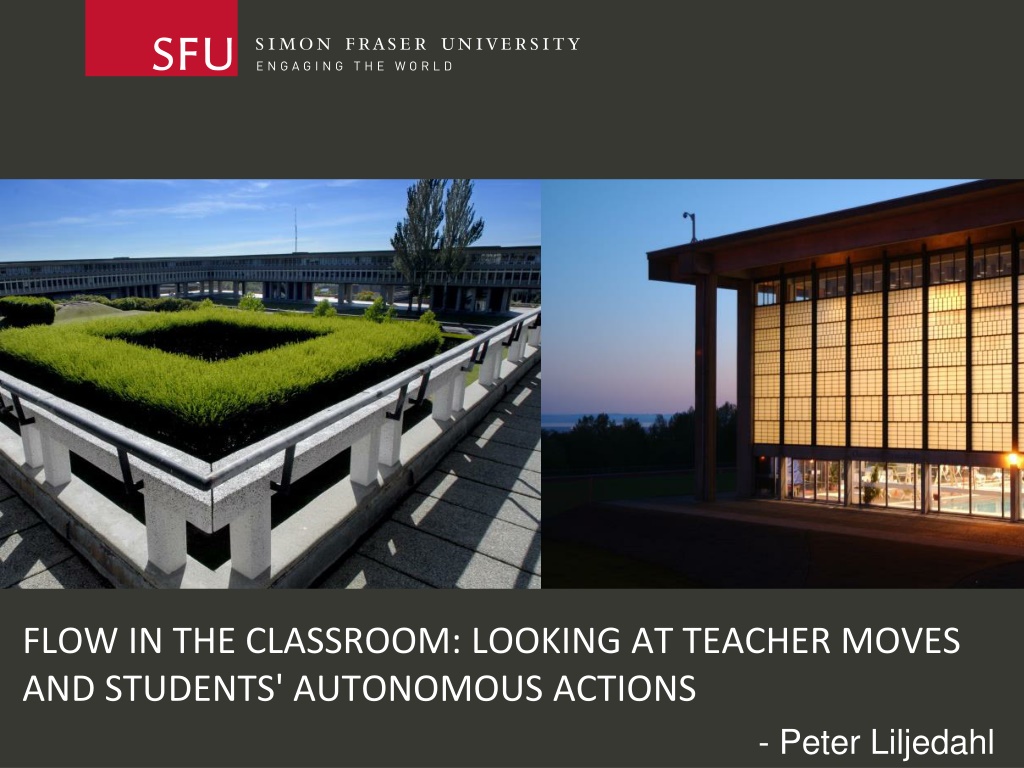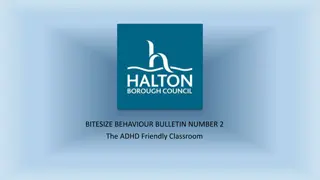Exploring Flow in the Classroom and Optimal Experience
This content delves into the concepts of flow in the classroom and optimal experience, focusing on teacher moves, students' autonomous actions, and the key elements that contribute to an optimal experience according to Csikszentmihalyi. The research by Peter Liljedahl sheds light on how clear goals, immediate feedback, the balance between challenges and skills, and other factors can enhance the learning environment. Understanding flow and optimal experience can provide valuable insights for improving teaching practices and promoting student engagement.
Download Presentation

Please find below an Image/Link to download the presentation.
The content on the website is provided AS IS for your information and personal use only. It may not be sold, licensed, or shared on other websites without obtaining consent from the author. Download presentation by click this link. If you encounter any issues during the download, it is possible that the publisher has removed the file from their server.
E N D
Presentation Transcript
FLOW IN THE CLASSROOM: LOOKING AT TEACHER MOVES AND STUDENTS' AUTONOMOUS ACTIONS - Peter Liljedahl
liljedahl@sfu.ca www.peterliljedahl.com/presentations @pgliljedahl
Liljedahl, P. (2016). Flow: A Framework for Discussing Teaching. Proceedings of the 40thConference of the International Group for the Psychology of Mathematics Education, Szeged, Hungary. Liljedahl, P. (under review). On the edges of flow: Student problem solving behavior. In S. Carreira, N. Amado, & K. Jones (eds.), Broadening the scope of research on mathematical problem solving: A focus on technology, creativity and affect. New York, NY: Springer.
THE OPTIMAL EXPERIENCE MIHALY CS KSZENTMIH LYI
1. There are clear goals every step of the way. 2. There is immediate feedback on one s actions. 3. There is a balance between challenges and skills. 4. Attention is focused on one s actions. 5. Distractions are excluded from consciousness. 6. There is no worry of failure. 7. Self-consciousness disappears. 8. The sense of time becomes distorted. 9. The activity becomes satisfying in its own right. - Cs kszentmih lyi (1990) OPTIMAL EXPERIENCE
1. There are clear goals every step of the way. 2. There is immediate feedback on one s actions. 3. There is a balance between challenges and skills. 4. Attention is focused on one s actions. 5. Distractions are excluded from consciousness. 6. There is no worry of failure. 7. Self-consciousness disappears. 8. The sense of time becomes distorted. 9. The activity becomes satisfying in its own right. - Cs kszentmih lyi (1990) OPTIMAL EXPERIENCE - internal
1. There are clear goals every step of the way. 2. There is immediate feedback on one s actions. 3. There is a balance between challenges and skills. 4. Attention is focused on one s actions. 5. Distractions are excluded from consciousness. 6. There is no worry of failure. 7. Self-consciousness disappears. 8. The sense of time becomes distorted. 9. The activity becomes satisfying in its own right. - Cs kszentmih lyi (1990) OPTIMAL EXPERIENCE - external
1. There are clear goals every step of the way. 2. There is immediate feedback on one s actions. 3. There is a balance between challenges and skills. ANXIETY BOREDOM OPTIMAL EXPERIENCE
1. There are clear goals every step of the way. 2. There is immediate feedback on one s actions. 3. There is a balance between challenges and skills. ANXIETY BOREDOM FLOW EXPERIENCE
1. There are clear goals every step of the way. 2. There is immediate feedback on one s actions. 3. There is a balance between challenges and skills. ANXIETY = ENGAGEMENT BOREDOM FLOW EXPERIENCE
ANXIETY BOREDOM FLOW EXPERIENCE
ANXIETY BOREDOM FLOW EXPERIENCE
ANXIETY BOREDOM FLOW EXPERIENCE
ANXIETY BOREDOM MOMENTS OF IMBALANCE
STUDY 1 What do teachers do in a moment of imbalance? STUDY 2 What do student do in a moment of imbalance? TWO STUDIES
Purposive sampling effective mathematics teachers 15 teachers 6 participants Video of a typical lesson Claire teaches primarily the senior (grades 11 and 12) academic courses Connor teaches all levels of high school mathematics teaches some junior (grades 8 -10) science METHODOLOGY
Claire's Lesson (grade 11) solving trigonometric ratio problems 00:00 Claire begins with a brief review of the previous lesson. 06:30 Claire delivers a 'lesson' on calculating the angle (0o < 360o) given a trigonometric ratio r. This lesson involves her giving several examples of how to solve such tasks. 22:00 Claire asks the class to solve for : sin = 0.8, cos = 0.32, and tan = 1.2. During this activity Claire circulates and checks on how students are doing. When a student puts up their hand she quickly moves to them and answers their question. The first two questions asked by students pertained to the fact that the ratio for the third question (tan = 1.2) is greater than 1. 26:15 Claire stops the activity to re-explain the limitations on the ratios for each trigonometric relationship. 31:00 Claire calls the class to attention and goes over the solutions to each of the three questions. 36:30 Claire gives the next question for the students to solve (solve for : 3sin + 1 = 2.8; 0o < 360o). Almost immediately many students put up their hands. Claire helps two students to understand the task and begin to solve it. 40:00 Claire calls the class to attention and reviews how to solve the equation 3x + 1 = 2.8. 42:30 Claire refocuses the students on the original task: 3sin + 1 = 2.8. 50:00 Claire calls the class to attention and goes over the solutions to the question. 55:30 Claire assigns homework. CLAIRE
Liljedahl, P. (2016). Building thinking classrooms: Conditions for problem solving. In P. Felmer, J. Kilpatrick, & E. Pekhonen (eds.), Posing and Solving Mathematical Problems: Advances and New Perspectives. (pp. 361-386). New York, NY: Springer. Liljedahl, P. (2014). The affordances of using visibly random groups in a mathematics classroom. In Y. Li, E. Silver, & S. Li (eds.), Transforming Mathematics Instruction: Multiple Approaches and Practices. (pp. 127-144). New York, NY: Springer. CONNOR
a classroom that is not only conducive to thinking but also occasions thinking, a space that is inhabited by thinking individuals as well as individuals thinking collectively, learning together and constructing knowledge and understanding through activity and discussion. It is a space wherein the teacher not only fosters thinking but also expects it, both implicitly and explicitly(Liljedahl, 2016b, p.364) CONNOR
levelling assessment flow answering questions oral instructions defronting good problems vertical non- permanent surfaces visibly random groups a classroom that is not only conducive to thinking but also occasions thinking, a space that is inhabited by thinking individuals as well as individuals thinking collectively, learning together and constructing knowledge and understanding through activity and discussion. It is a space wherein the teacher not only fosters thinking but also expects it, both implicitly and explicitly(Liljedahl, 2016b, p.364) CONNOR
Connor's Lesson (grade 11) factoring quadratics 00:00 Connor reviews how to multiply two first degree binomials on the board: (x + 2)(x + 3) = x2 + 5x + 6. He then asks the question, "what do the binomials have to be if the answer is x2 + 7x + 6?" 01:30 Connor places the students into random groups and asks them to work on vertical whiteboards to find the answer. He then begins to circulate amongst the groups as they begin to work. 05:00 Connor stops to speak with a group who is having trouble understanding the task. He re-writes the example as follows: (x + 2)(x + 3) = x2 + 5x + 6 (?)(?) = x2 + 7x + 6 He then points to the question marks and asks, "what has to go in here so that the product of the two binomials is this (pointing at the quadratic expression)? I'll give you a hint look at the last number." 07:00 Connor asks a group who has an answer to check their solution by multiplying the binomials. Once the solution is confirmed he gives the group a new task: x2 + 6x + 8. 08:30 Connor gives a new task to two groups asking them first to check their answer. 09:00 For the next 32 minutes Connor moves around the room giving new tasks and helping groups that are stuck. Eventually Connor projects a list of 20 progressively challenging tasks onto a wall. These range from the initial task of x2 + 7x + 6 to tasks as complex as 6x2 + 10x - 4. The groups start to move through these tasks one by one solving each and checking their answers. 41:00 Connor gathers the students around one whiteboard and asks them to walk him through how to solve the question x2 + 5x 24. Connor forces the students to articulate their thinking at each step. 47:00 Connor suggests that the students sit down and write down some notes for themselves. 52:00 Connor projects five more tasks on the wall and asks the students to solve them on their own. CONNOR
CLAIR in the first activity the challenge of the tasks is reduced for the whole class through the explicit lesson on, and examples of, how to solve these types of tasks Clair then lowers the challenge even further in the middle of the activity by reviewing the range of ratios possible everyone was given the second more challenging activity at the same time the challenge of this activity is then reduced for the whole class when Claire shows how to solve an analogous algebraic task CONNOR Connor regulates the challenge of each task according to the ability of each individual group groups who need help receive individualized help groups whose ability allows them to solve a task are given a more challenging task to work on eventually the groups are shown how to check their own solutions and from then on they are able to increase the challenge of the activity as their ability increases REGULATING CHALLENGE
ANXIETY BOREDOM CLAIR - SYNCHRONOUS
ANXIETY BOREDOM CONNOR - ASYNCHRONOUS
Liljedahl, P. (2016). Building thinking classrooms: Conditions for problem solving. In P. Felmer, J. Kilpatrick, & E. Pekhonen (eds.), Posing and Solving Mathematical Problems: Advances and New Perspectives. (pp. 361-386). New York, NY: Springer. Liljedahl, P. (2014). The affordances of using visibly random groups in a mathematics classroom. In Y. Li, E. Silver, & S. Li (eds.), Transforming Mathematics Instruction: Multiple Approaches and Practices. (pp. 127-144). New York, NY: Springer. METHODOLOGY TEACHING STYLE
levelling assessment flow answering questions oral instructions defronting good problems vertical non- permanent surfaces visibly random groups Liljedahl, P. (2016). Building thinking classrooms: Conditions for problem solving. In P. Felmer, J. Kilpatrick, & E. Pekhonen (eds.), Posing and Solving Mathematical Problems: Advances and New Perspectives. (pp. 361-386). New York, NY: Springer. Liljedahl, P. (2014). The affordances of using visibly random groups in a mathematics classroom. In Y. Li, E. Silver, & S. Li (eds.), Transforming Mathematics Instruction: Multiple Approaches and Practices. (pp. 127-144). New York, NY: Springer. METHODOLOGY TEACHING STYLE
BUILDING THINKING CLASSROOMS 1. visibly random groups 2. vertical non-permanent surfaces 3. good problems 4. flow to guide hints and extensions (Connor) 5. levelling to the bottom METHODOLOGY TEACHING STYLE
two classrooms (grade 11 &12 pre-calculus) watching for moments of imbalance video didn t work (too narrow a field of vision) field notes photographs interviews NOTEABILITYTM METHODOLOGY - THE DATA
CAMERON uses only curricular tasks (progressively harder) levels to the bottom after 2-3 questions levels to the bottom at end of lesson no homework CHARMAINE uses non-curricular tasks 2-3 times a week as warm-up uses curricular tasks (progressively harder) levels to the bottom with 25 minutes to go assigns 3-5 questions to do for the remainder of class with whom you want and where you want METHODOLOGY THE CLASSROOMS
ANXIETY BOREDOM CREATE AND MAINTAIN FLOW
ANXIETY BOREDOM MOMENTS OF IMBALANCE
ANXIETY BOREDOM CHALLENGE TOO LOW
Researcher I notice you are not working on the assigned questions. What's up? Mikaela We did some of them. Researcher I saw that. I noticed that you did two very quickly. Took a little break from the math and then went back and did another one. I was sort of waiting to see if you would get back to it. Allison This stuff is easy. I'll finish it at home on my own. Mikaela Its actually too easy. I don't even think I will bother finishing it at home. Allison Yeah. I probably won't either. Researcher It's easy? Is that why you stopped working on it? Mikaela Yeah. Researcher I saw you two work together before at the end of class. I don't recall seeing you two giving up before. Allison We aren't giving up. Sometimes we don't finish all the questions because they are hard and we run out of time. But these are easy. Researcher What makes them easy. Mikaela They just are. The first three are exactly the same and we could do them no problem. CHALLENGE TOO LOW: CASE 1 (n=4)
Researcher So, I notice that you guys are now on question 5 and your teacher has not visited you once. How are you getting your questions? Ameer We just look around and see what the next question is and do that one. Researcher What would your teacher say about that? Carl Um he'd probably want to check to see that we got the previous one before giving us the next one Ameer but we are doing that. Researcher Why don't you just wait for your teacher to get here and give you the next question? Carl We're on a roll. And sometimes we have to wait a long time. Researcher Do you realize that you are doing the problems out of sequence from the order your teacher is giving them? Colton Oh really? That s probably why some were so hard. CHALLENGE TOO LOW: CASE 2 (n>20)
Researcher I have been watching you while I have been here. I notice that you always do a lot of questions. Can you tell me about that? Jennifer Yeah. I like to do a lot of questions. It's good practice. It's how I learn. Researcher So, are you looking for harder and harder questions to challenge yourself. Jennifer Not really. I just do all of them. So, if the teacher asks us to do 4a, I will also do 4bc and d and so on. Researcher Do you find them easy. Jennifer Yeah.. Researcher How many do you do? Jennifer I just work the whole time at the end of class and then for maybe an hour at home. CHALLENGE TOO LOW: CASE 3 (n=3)
ANXIETY BOREDOM CHALLENGE TOO HIGH
Researcher I have been watching your group for a bit and I notice that you arent working? Robert We gave up. This question is stupid. Katrina We tried, but we weren't getting anywhere. So we gave up. Researcher What do you think the problem is? Shannon This question is too hard. Robert too hard. We don't get it. Katrina And the teacher hasn t come over to help us. Researcher What kind of help are you looking for? Shannon You know, a hint or something. Researcher What would a hint do for you. Shannon Help us understand the question. Katrina or remind us a little bit about how to do it. CHALLENGE TOO HIGH: CASE 1 (n=6)
Researcher I notice that you have been moving about the room a bit. Why? Michael Oh. We were just stuck so we went over there to get some ideas. Researcher Did it help? Michael Oh yeah. We got it now. Mikaela Michael got it. It took me a little longer, but I'm good now. Researcher You were also moving around a little bit earlier in the class? Mikaela Oh, you mean when we were checking answers? Yeah, we thought we were doing something wrong, but we were good. Researcher Lena, you like to look around a lot. Lena I do? What do you mean? Researcher You know, when Michael was working on the board you look around a lot at the other groups. Lena Right. I am just making sure we are on the right track. CHALLENGE TOO HIGH: CASE 2 (n>20)
Researcher Question #5 was a tough one, huh? Oliver Yeah, that one took us a while. Connor In the end it wasn't that hard though. We were just missing something. Researcher Oh really. How did you figure it out? Connor We just kept at it and then we saw it. Researcher I noticed that your teacher came over to help. Did she help you? Oliver No, we wouldn't let her. We knew we knew how to do it and we wanted to figure it out ourselves. CHALLENGE TOO HIGH: CASE 3 (n=2)























